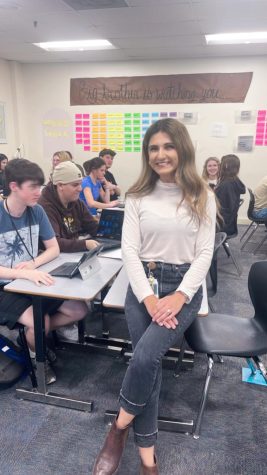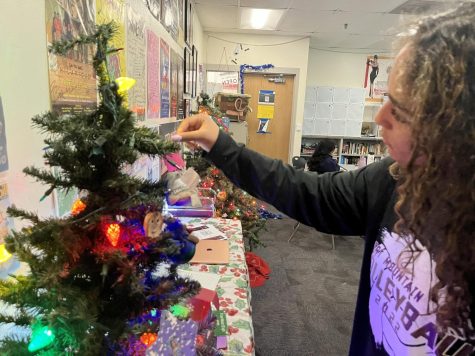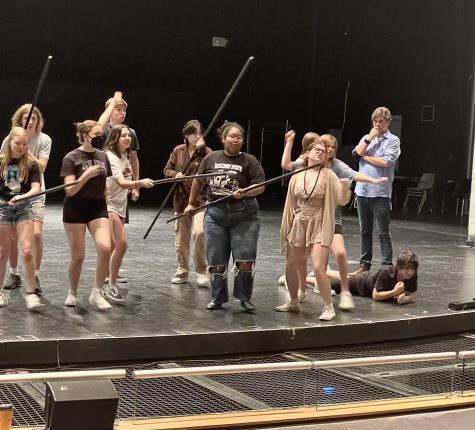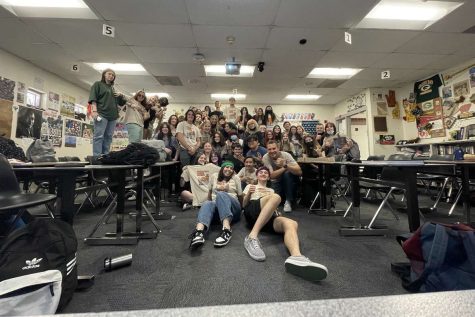An artist’s alcove
Mrs. Wilkins’s art room home for many DM art students

ICONIC CLASSROOMS OF DM–Christopher Lessler will spotlight the classrooms that students say provide more than just a place to study and learn–but a place to live.
April 19, 2022
From the sewing space to the easels, from the mannequins to the army of art supplies always at the ready, from the students who seemingly always are creating to the walls of their work serving as evidence, Mrs. Wilkins’ iconic art room is packed with anything and everything art-related.
“It can be a little overwhelming, walking in here,” admits Mrs. Wilkins, who hosts students all six periods of the day in art classes ranging from Studio Art I to IB and AP art courses.
But her students wouldn’t have it any other way.
“We just spread our creativity everywhere,” says AP Drawing and Painting student Hannah Seratte (12).
AP Drawing and Painting student Kylie Nay (12) says she loves all the plentiful “crevices where you find things you wouldn’t expect.”
The one caveat? “It’s their job to take care of all of it,” Mrs. Wilkins said.
“This classroom changes function from year to year, depending on what the student needs are,” Mrs. Wilkins said, especially since she never tries to force her own idea of order upon her students—except for making sure the floor stays organized, for safety reasons.

Mrs. Wilkins employs every square inch of space available, even after expanding into former patio space.
Before the expansion, the art room was crowded and congested. “As a teacher, I felt that the students were restricted to just their assigned seat or zone,” said Mrs. Wilkins.
“Students need to work on easels; students need to spread out,” Mrs. Wilkins said. “So getting them the opportunity to treat the classroom more like a working studio was essential for the success of our programs.”
Even with the expansion, some patio space remains.
“We come out here when it rains,” Seratte said, adding that earlier this year the art class also viewed the student council’s parade from the patio.
“My IB students and AP students tend to be involved in a lot, and everybody is doing something different,” Mrs. Wilkins said. Therefore, the room must be highly organized.

“I think what’s been really important for me is to have things labeled and well enough organized so when the students need spun fibers, they know where to get them, if they need unspun fibers, if they need printing materials, if they need acrylic paints, especially the upper-level students, we can point them in that direction,” Mrs. Wilkins said.
We just spread our creativity everywhere.
— AP Drawing and Painting student Hannah Seratte (12)
IB art student Julia Lange (12), an art room regular, chimed in: “There’s always a system.”
“Good; there’s supposed to be a system,” Mrs. Wilkins interjects.
“Because I’m an artist, color is a natural way to coordinate things,” Mrs. Wilkins adds, hence her system of assigning different colors to different art courses.
“All of my Art I bins are purple,” said Mrs. Wilkins. “So if I’m teaching and a student was absent yesterday, they grab the purple bin. If they have anything extra, they dump it off in the purple bin.”
IB art student Jameson Perreault-Perez (12) “just find(s) color coding to be easier.”
“It definitely does help students,” he said. “Because I know, if something is green or it’s in a green folder or a green portfolio, or something like that, I just know that it’s for IB.”

Mrs. Wilkins says some students even liked her color coding enough to implement it themselves at home. In fact, Parreault-Perez had started organizing by color even before Mrs. Wilkins.
And it’s not just the organization that Mrs. Wilkins’s art students love.
It’s the classroom as a whole.
“I think the students are pretty excited,” Mrs. Wilkins said, “to get to call this their space this year.”










